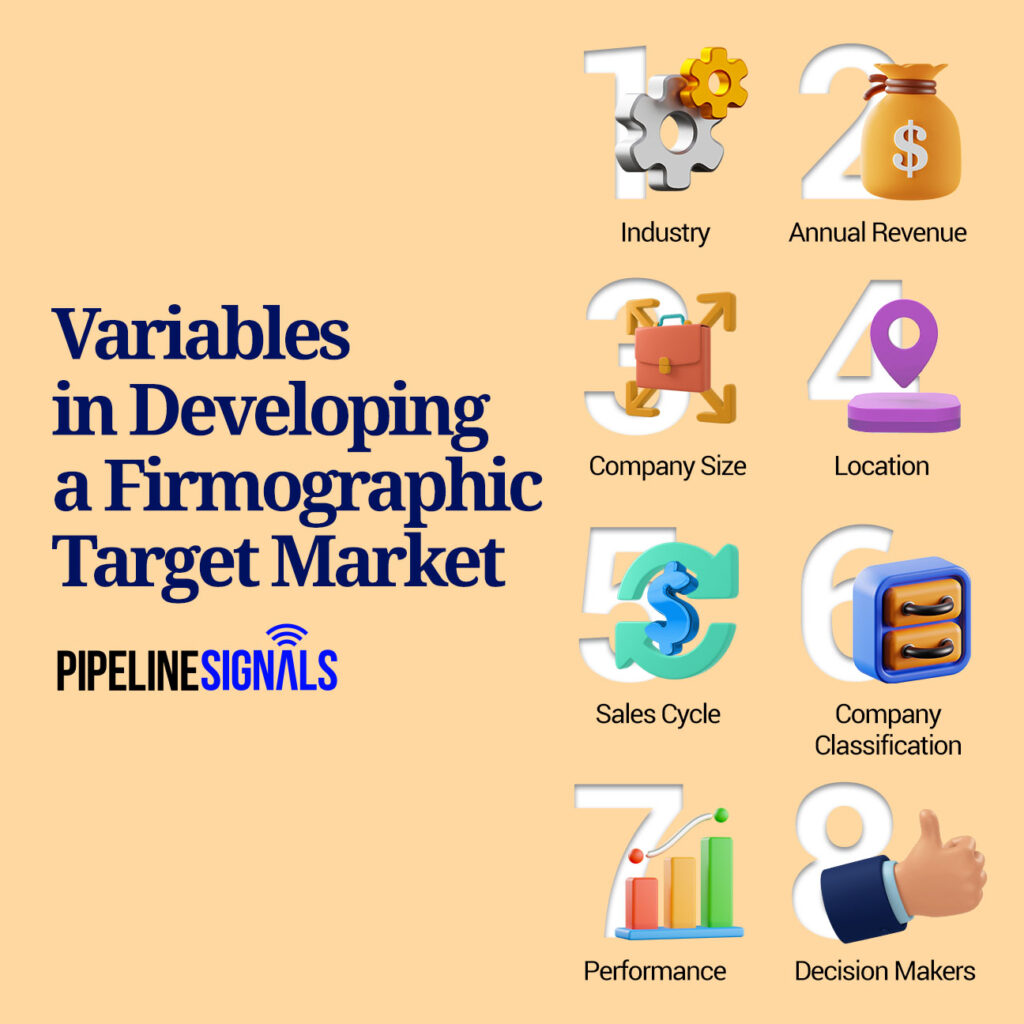To get a more accurate image of their consumer base, every business needs firmographics segmentation. They can then organize accounts based on their commonalities and provide targeted marketing to specific segments. Consequently, more conversions occur from these highly tailored messages.
There is no single consumer segmentation approach that will increase conversions for every brand because one method may prove to be more effective than another in each scenario. Firmographic segmentation is non-negotiable in the pipeline creation process.
What are firmographic insights?
Firmographics can be found in corporations, organizations, governmental agencies, businesses, non-profits, and any other type of company. Corporations use this data in the same manner that individuals use demographic information to segment and target prospective clients.
The data, usually collected and offered as a service by many B2B data providers, is used to organize enterprises into functional categories. Firmographic uses include industry and market research, B2B marketing strategies, and competitive intelligence.
Businesses use Firmographics to define their target market to develop their B2B sales techniques and marketing. Regardless of the type of business product or service sold, various business consumers will want different degrees of business products and services. It enables businesses to develop a sales strategy and marketing communications focused on companies most likely to respond to or buy their products.
Importance of firmographics
Businesses can concentrate their sales and marketing initiatives on the accounts that are most likely to engage with their messaging and buy the goods or services being offered by grouping enterprises with identical firmographics collectively.
Firmographics give marketing teams information on who is buying specific items, and who isn’t buying those items, and a deeper understanding of B2B clients and the market as a whole.
Reveal business insights
Firmographics, much like compelling event signals, assist firms in gaining business insights by answering questions such as where the businesses in this target market are situated geographically, how many workers they employ, what is the valuation of each company, and how large is the Total Addressable Market, among many others.
Categorize firms by industry or Sector
Firmographics allows B2B companies to categorize companies in their target markets based on their industry type. Automotive businesses, for example, will have different distinguishing characteristics than construction firms or government agencies. As a result, these businesses should be approached and presented differently.
Optimize marketing strategies
A company’s marketing strategy can be confident if it promotes adequately focused and personalized messaging that corresponds with the main issues of each market segment. Most marketers strive to send the appropriate message to the right person at the right time, and firmographic data can help them achieve that goal.
Avoid lost opportunities
Optimizing marketing techniques and employing a data-driven sales approach decreases the danger of missing out on business possibilities.
Understand trends in data
B2B marketers can recognize patterns in data by evaluating reports and analytics from firmographic segmented marketplaces. These patterns can subsequently be taken into consideration throughout marketing and sales operations, resulting in increased efficacy.
What is firmographic segmentation?
The categorization of B2B clients based on standard business or organization attributes or factors is known as firmographic segmentation. By giving deeper company insights, this method can help influence marketing, advertising, and sales, ultimately leading to more focused and effective campaign tactics.
If your company sells to businesses, you’ll need to grasp a different collection of facts. Some are tied to demographics, but others are distinct and might change significantly based on the business or industries you work.
Depending on your product, you’ll need to know a variety of firmographics. Other information is more vital to comprehend for every product and every company that creates it. The objective is to incorporate as many components as possible to either confirm your current hypothesis or offer new revenue opportunities.
Any B2B organization can benefit from firmographic segmentation since it gives crucial marketing data. The more data you have about your potential B2B client, the better you can tailor your message. Personalization and customization tailored to a specific audience will increase the likelihood of your message resonating and converting.
If you keep firmographic segmentation in mind throughout the B2B sales process, you may be successful in your attempts to find the proper business connection.
Various variables utilized to develop a firmographic target market
B2B marketers leverage a plethora of characteristics to generate effective market segmentation based on firmographics. The following are a few of the most prevalent.


Industry or sector
Some accounts are more likely to avail of your goods and services according to the industry they belong in. A firm in the car industry that wants to invest in current automotive technology will not be interested in a merchant selling building supplies.
Businesses can tailor their advertising efforts to each industry by grouping these enterprises. This is a better technique than sending the same material to all industries and hoping it gets through.
Yearly revenue
Revenue is essential because you want to market to organizations that can afford what you have to offer, rather than spending ad dollars on prospects who can’t.
Your software may be less expensive than competitors, making it more appealing to small businesses with lower yearly sales. Ordinarily, you want to concentrate on smaller companies that are more likely to be interested in your offer.
Always perform your homework before making assumptions about possible clients and income because the reality is sometimes quite different. For example, a company that typically generates more money may be facing a financial slowdown, making your low-cost product more appealing to them right now.
Size of the company
Because different-sized organizations are likely to respond differently to diverse messages and advertising methods, the number of employees a company counts. When utilizing firm size as a firmographic variable, consider the following: is your target firm a large corporation, or does it operate on a smaller scale? Are they expanding or contracting? Do tiny businesses, emerging mid-sized businesses, or established industry leaders prefer your products?
Answering these questions and segmenting your audience based on their responses allows you to target your advertising efforts more precisely.
Geographic location
Location firmographics refer to the geographic location of a target business – continent, country, state, region, city, etc. Are they in a big metropolis or a tiny village far away? Is the company well-known on a global scale? What is the distance between you and the advertising company?
Consider a company in Southeast Asia that doesn’t do much business with a company in New York. The company should not devote much time or money to working with the New York firm or any other firm outside its immediate region.
However, it’s also crucial to determine whether the advertising firm has many locations worldwide or if they simply have one. While the primary headquarters may not be close to the customer, another location may be.
Sales cycle
The information you give a potential customer should be tailored to their B2B buying process stage. Are they ready to buy now, or are they just gathering information to make a decision later? Monitoring trigger signals can usually determine this.
It aids in the progression of consumers through the sales funnel by fostering relationships and gaining a psychological grasp of their wants and needs before moving them to the next step.
Lead nurturing may also help you figure out how long it takes a buyer to perform thorough research and make an informed buying decision, as well as how much time you’re wasting on someone who isn’t planning to buy anytime soon. You might easily squander time and money by advertising to firms that never intend to buy if you don’t correctly understand the sales cycle.
Classification or status
Individual businesses, limited liability corporations, stand-alone entities, subsidiaries, partnerships, government-owned companies, and privately held businesses all have a status or structure that describes their relationship to one another or their legal status.
Knowing which businesses find the most value in your products and services can help sales, advertising, and marketing efforts be more effective. Identifying compelling event signals, aided by firmographics, will assist every salesperson in determining which accounts are more valuable and which aren’t.
Performance
Firmographic segmentation by performance is the grouping of organizations based on factors linked to business execution through time, such as the duration of existence, growth or decline rates, profits, losses, etc.
Similarities in any of these areas may indicate that the companies require a shared solution, such as your good or service.
Decision-makers
All the abovementioned factors can be used to create your perfect customer profile. They can, however, assist with account-based marketing, which is crucial when attempting to reach out to other organizations.
Account-based marketing is required to engage those in charge of purchasing choices, and executive title firmographics make it easier to create lists of such individuals and accounts.
B2B marketing strategies are all about targeting the appropriate accounts at the right moment. Regardless of your end objective, firmographics data, and the trigger signals it can provide, is one of the most effective methods to do it.
Conclusion
Firmographic market segmentation reveals valuable information that may be used to develop and inform advertising strategies. You’ll benefit from more advertising options, a more targeted message, and increased ROI by grouping prospective organizations based on similar characteristics.
The more you know about a prospect, the more personal your value proposition may be, and the more likely it is to resonate and lead to the desired action. Make sure you maintain relevancy in the post-click stage once you’ve tailored advertising for your target audience.


